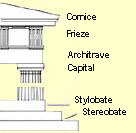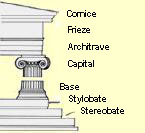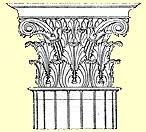Architectural Orders



Greek architects devised standard 'orders' of stone architecture, applied mainly in terms of the details of columns and entablature of major buildings.
DORIC - An architectural order devised in central Greece in the 7th century BC, based on the wooden forms of earlier architecture. Columns have plain capitals (echinus), at first rounded but becoming straight-sided with time, fluted shafts and no bases. The upperworks include a
frieze of
metopes (rectangular panels) and triglyphs (vertical dividers). It is most common in mainland Greece, South Italy, and Sicily, but less common after the 4th century BC. Prime examples are the Temple of
Zeus at
Olympia, and the
Parthenon at
Athens.
IONIC - An architectural order devised in East Greece (Ionia) in the 6th century BC, deriving from earlier floral and furniture patterns of oriental type. Its columns have fluted shafts, elaborately moulded disc bases and volute capitals. The upperworks have a continuous
frieze, usually with dentils (copying beam ends). From the 4th century BC onwards its design of capital becomes increasingly replaced by the
Corinthian. Prime examples are the
Erechtheion at
Athens and the Temple of
Athena at Priene. There was a related 6th-century 'Aeolic' order in northern East Greece, simpler, but with volute capitals of different origin.
CORINTHIAN - An alternative order of architecture to the Ionic, its capitals being four-sided and composed of small corner volutes and a basket-shaped body decorated with rows of acanthus leaves. Invented in the later 5th century BC and most popular in the Roman period.
Above left: Drawing of Doric order. J. Boardman, Greek Art, fig.250 (Garth Denning). © Garth Denning Licence Plate 11 UK 1007 137
Above middle: Drawing of Ionic order. J. Boardman, Greek Art, fig.250 (Garth Denning). © Garth Denning Licence Plate 11 UK 1007 161
Above right: Drawing of Corinthian capital. D.S. Robertson, Greek and Roman Architecture, fig.62. © Olympia, die Ergebnisse: Die Baudenkmaler Licence Plate 11 UK 1007 130


